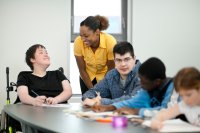High Expectations for Students With Multiple Impairments
A special education teacher shares insights on adapting the Common Core Essential Elements for students with multiple impairments.
Your content has been saved!
Go to My Saved Content.I’m a special educator, serving some of the most severely cognitively and physically impaired students on the special education continuum. Most students in our severe multiple impairment (SXI) classrooms do not have the use of their hands or arms, and 95 percent are completely nonverbal. Many have impaired vision or hearing, are tube-fed, have tracheotomy tubes, or have seizures or complicated behaviors that interfere with learning. These disabilities affect less than 1 percent of the population.
We service our students in a center-based special education building. Six years ago, our work focused on tending to their complex medical needs, addressing behaviors, prioritizing life skills, and working toward independence. This was a lot to do, and we did it well. Our students had academic work, but it wasn’t our primary focus.
As a center-based teacher, I was asked to participate in a committee at the county examining a new set of state standards, the Common Core Essential Elements. These were based on the Common Core and were designed for students with special needs in Michigan.
As these new academic standards were revealed to the committee, my colleagues in the room became upset. They pleaded with the presenter to give our kids credit for the things they can do. People said it would be impossible for our kids to meet the standards.
But what if we didn’t assume that meeting the standards was impossible? What if our students with the most severe impairments were presented material similar to their grade-level peers?
Implementing the Common Core Essential Elements
We decided to use the Common Core Essential Elements as our road map, detailing the destination for our students; however, we knew the route to get there would be much different from that of their special education peers with mild or moderate impairments.
We began our journey by examining our philosophy, and made a decision to expose our students to the new standards and see what would happen. It was an important place to start.
Introducing academic content meant lots of adaptations—creating visual representations of concepts; using voice output devices, picture cards, adaptive equipment, braille materials, and 3D objects for our students with visual impairments; different types of equipment and technology for our students with physical limitations; and lots and lots of lesson preparation.
This transformation over the past six years was championed by our school principal, who created a school culture that made it safe for us to fail as long as we tried again.
We did not abandon the focus on self-care and independence, but worked on those skills as opportunities arose naturally throughout the day. We bought lots of books and built a school library, and our teachers dove in to adapting age-appropriate books. This included literary classics like To Kill A Mockingbird and Holes because every kid deserves to meet Scout Finch and Stanley Yelnats.
We invested time in our professional learning communities to work with one another. We studied the Four Blocks literacy program—which focuses on guided reading, self-selected reading, writing, and working with words. “I Can” statements were written in four levels of difficulty for each standard, which helped describe how our most severely impaired students interacted with the Common Core Essential Elements. We created lots of materials and increased direct instruction time.
Indications of Progress
Slowly we started to see changes. There were moments in classrooms that let us know we were headed in the right direction. This didn’t necessarily mean mastery of material—it was more a matter of decreased levels of prompting needed to get students to engage on some level with instruction.
Later, the county brought in training on a writing curriculum for our students. Once again we heard that it would never work. But our teachers brought the curriculum back to the center and dove in. They began with the writing mini-lessons and picture topic boards, and adapted alphabet boards students would use to choose letters to form words.
A moment of success: Brandon, a student with severe multiple impairments, wrote a sentence using one of our adapted letter boards. He selected a picture of himself and wrote, “I am hansom.” For every win like this we have another obstacle or a failed lesson, but we always try again.
The example of Brandon teaches us a lot of things, but my top two takeaways are that teaching in this population is a marathon—with milestones few and far between—and that if we act as if students can do something, they just might be able to.
As Martin Pistorius writes in Ghost Boy: The Miraculous Escape of a Misdiagnosed Boy Trapped Inside His Own Body, “If someone does not expect or is not expected to achieve, then they never will.” Our work shows that if we do expect someone to achieve, they may.
